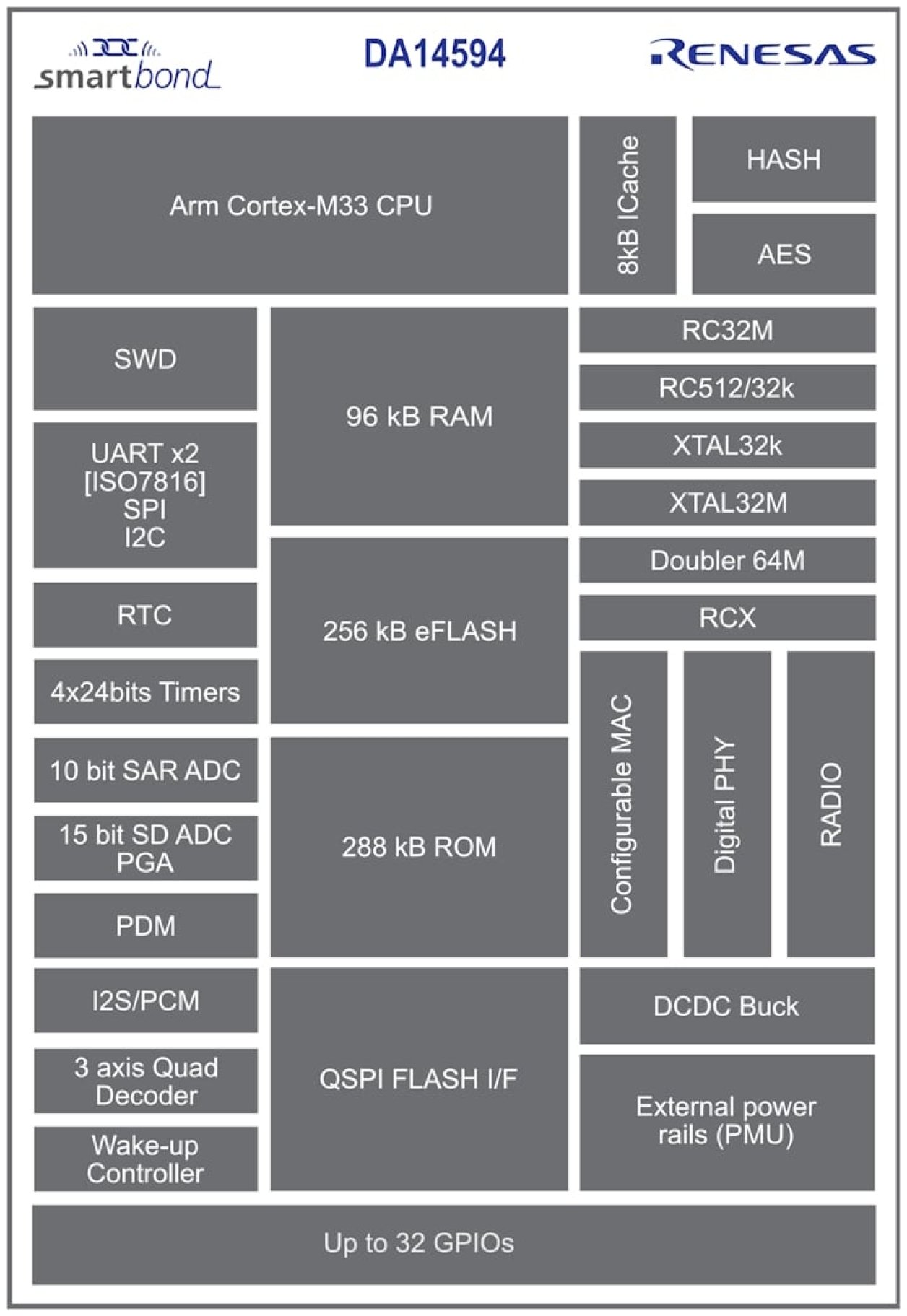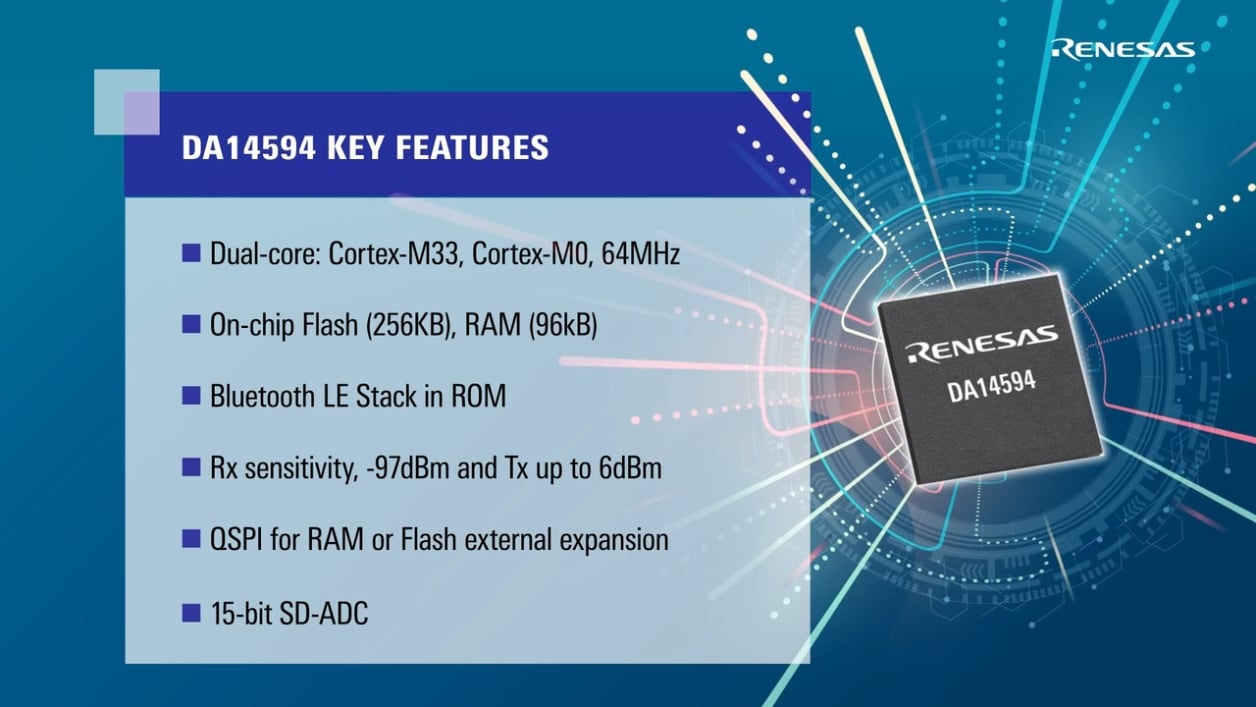Features
- Dual-core: Cortex-M33F at 64MHz as application core, M0+ at 64MHz as configurable MAC
- Bluetooth features: Direction Finding, Extended Advertising, Periodic Advertising
- Locationing 2.0 Tx: AoA/AoD, ATLAS AoA, Eddystone, iBeacon, WiRa Gen3 Responder
- Receive sensitivity -97dBm, Transmit +6dBm
- 96kB RAM (+16kB Cache), 256kB Flash, 288kB ROM (incl. stack), QSPI external Flash or RAM expansion
- 8-ch, 15-bit Sigma-delta analog-to-digital converter (ADC)
- Power consumption: Rx = 1.2mA, Tx = 2.3mA, Active = 34uA/MHz, Hibernation = 90nA
- Only requires 6 external components
- Security: Secure key storage, secure boot
- Quad-decoder (active in hibernation)
- WLCSP (3.32x2.48mm), FCQFN (5.1x4.3mm)
Description
The DA14594 is a dual-core wireless microcontroller, combining the latest Arm® Cortex®-M33™ application processor with floating-point unit, Cortex-M0+™, advanced power management functionality, a cryptographic security engine, analog and digital peripherals, a software configurable protocol engine with a radio that supports Bluetooth® LE (qualified against Bluetooth Core 5.3) and 256KB of embedded flash accompanied by 96KB of RAM, 16KB of cache RAM, and 288KB ROM (containing the Bluetooth Low Energy (LE) stack). The embedded flash or SRAM may be expanded externally through QSPI.
The DA1459x family offers the lowest power consumption in its class, and the DA14594 also offers ‘Locationing 2.0’ customers the lowest power and lowest cost SoC for implementing Asset Tracking and Locationing At Scale (ATLAS) Angle of Arrival (AoA) Tags and Wireless Ranging (WiRa™) phase-based ranging Responders.
The DA14594 is based on an Arm Cortex-M33 CPU with an 8-region MPU and a single-precision FPU offering up to 96dMIPS at 64MHz. The dedicated application processor executes code from embedded flash or RAM via an 8KB 4-way associative cache controller. The authenticity and integrity of Bluetooth connectivity is guaranteed by a new software-configurable Cipher-based Message Authentication Code (CMAC) implementation based on an Arm Cortex-M0+ with an ultra-low-power radio transceiver, capable of +6dBm output power and -97dBm sensitivity, offering a total link budget of 103dB.
A variety of standard and advanced peripherals enable interaction with other system components and the development of advanced user interfaces and feature-rich applications.
Parameters
| Attributes | Value |
|---|---|
| Wireless Standard | BLE 5.3 Core specification |
| Proprietary 2G4 protocol | Yes |
| CPU | M33 & M0+ |
| Flash Memory (KB) | 256 |
| ROM (KB) | 288 |
| Memory Size (OTP) (KB) | 2 |
| RAM (KB) | 96 |
| GPIOs (#) | 32 |
| Supply Voltage Vcc Range | 1.7-3.6 |
| Integrated DCDC | Integrated Buck DC-DC converter |
| Integrated Battery Charger | No |
| External Rails and Load Capacity | None |
| Tx Current (mA) | 2.3 |
| Rx current (mA) | 1.2 |
| Output Power Range (dBm) | -23 - 6 |
| Sensitivity (dBm) (dBm) | -97 |
| Clock Rate (MHz) | 64 |
| Flexible System Clock | Yes |
| Execute from FLASH | Yes |
| Hardware Crypto Engine | Yes |
| QSPI Interface (#) | 1 |
| SPI (#) | 1 |
| I2C (#) | 1 |
| UART (#) | 2 |
| ADC | 15-bit x 8-ch, 10-bit x 8-ch |
| USB Ports (#) | 0 |
| LE Data Length Extensions | Supported |
| 2Mbps | Supported |
| LE Coded PHY (Long Range) | Not Supported |
| Extended Advertising | Supported |
| Periodic Advertising | Supported |
| AoA | TX Supported |
| AoD | TX Supported |
| GATT Caching | Not Supported |
| Bluetooth® Mesh | Not Supported |
| Temp. Range (°C) | -40 to +85°C |
Product Comparison
| DA14594 | DA14592 | |
| RAM (KB) | 96 | 96 |
| Extended Advertising | Supported | Not Supported |
| Periodic Advertising | Supported | Not Supported |
| AoA | TX Supported | TX Supported |
| AoD | TX Supported | TX Supported |
| Application | ATLAS, AoA, AoD, Asset tracking, Beacons, HID, IoT, Medical, Metering, PoS, Wireless Ranging (WiRa) | AoA, AoD, Asset tracking, Beacons, Connected health, Crowd-sourced location tracking, HID, IoT, Medical, Metering, PoS, Proximity tags & trackers, RCU |
| GPIOs (#) | 32 | 32 |
| Pkg. Type | FCQFN, WLCSP | FCQFN, WLCSP |
Application Block Diagrams
| Automatic Pet Door & Tracking System Smart pet door with tag system for automatic entry and lost-pet tracking via proximity detection. | |
 | User Badge for Access and Tracking Rechargeable user badge with real-time tracking for secure access and personnel safety. |
| Bluetooth Low Energy Tags for Proximity and Asset Tracking Ultra-low power Bluetooth Low Energy asset tracker tag with high-precision accuracy. |
Additional Applications
- Locationing 2.0 Tag (AoA/AoD, ATLAS AoA, Eddystone, iBeacon, WiRa Gen3 Responder)
- Asset Tracking
- Connected Health
- Human Interface Device
- Activity Tracker
- Data Logger
- PoS Reader
- Metering
- High-end Voice RCU
- IoT End Node
- Toys
Applied Filters:
Filters
Software & Tools
Sample Code
Simulation Models
GitHub Examples Repository
Browse the GitHub example code repository for the DA1459x family.
The DA14594 is a Bluetooth® Low Energy (LE) System on Chip (SoC) designed for high performance and efficiency. Featuring a dual-core architecture, advanced power management, and a cryptographic engine, this SoC supports Bluetooth 5.3 LE and Locationing 2.0 technology for scalable asset tracking and precise positioning. This video provides an overview of its capabilities and applications.
This video demonstrates how to install e² studio for SmartBond™ device running SDK10.
Watch the Rest of the Quick Start Guide Below
- e² studio Quick Start Guide (2/3) - Import SDK10 Project for SmartBond™ Device
- e² studio Quick Start Guide (3/3) - Build and Debug for SmartBond™ Device Running SDK10
Related Resources
This video demonstrates how to import the SDK10 (Software Development Kit) project for the SmartBond™ device in e² studio.
Watch the Rest of the Quick Start Guide Below
- e² studio Quick Start Guide (1/3) - Installation for SmartBond™ Device
- e² studio Quick Start Guide (3/3) - Build and Debug for SmartBond™ Device Running SDK10
Related Resources
This video demonstrates how to build and debug for SmartBond™ device running SDK10 in e² studio.
Related Resources


